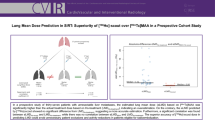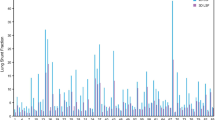Abstract
Purpose
Radiation pneumonitis is a rare but serious complication of radioembolic therapy of liver tumours. Estimation of the mean absorbed dose to the lungs based on pretreatment diagnostic 99mTc-macroaggregated albumin (99mTc-MAA) imaging should prevent this, with administered activities adjusted accordingly. The accuracy of 99mTc-MAA-based lung absorbed dose estimates was evaluated and compared to absorbed dose estimates based on pretreatment diagnostic 166Ho-microsphere imaging and to the actual lung absorbed doses after 166Ho radioembolization.
Methods
This prospective clinical study included 14 patients with chemorefractory, unresectable liver metastases treated with 166Ho radioembolization. 99mTc-MAA-based and 166Ho-microsphere-based estimation of lung absorbed doses was performed on pretreatment diagnostic planar scintigraphic and SPECT/CT images. The clinical analysis was preceded by an anthropomorphic torso phantom study with simulated lung shunt fractions of 0 to 30 % to determine the accuracy of the image-based lung absorbed dose estimates after 166Ho radioembolization.
Results
In the phantom study, 166Ho SPECT/CT-based lung absorbed dose estimates were more accurate (absolute error range 0.1 to −4.4 Gy) than 166Ho planar scintigraphy-based lung absorbed dose estimates (absolute error range 9.5 to 12.1 Gy). Clinically, the actual median lung absorbed dose was 0.02 Gy (range 0.0 to 0.7 Gy) based on posttreatment 166Ho-microsphere SPECT/CT imaging. Lung absorbed doses estimated on the basis of pretreatment diagnostic 166Ho-microsphere SPECT/CT imaging (median 0.02 Gy, range 0.0 to 0.4 Gy) were significantly better predictors of the actual lung absorbed doses than doses estimated on the basis of 166Ho-microsphere planar scintigraphy (median 10.4 Gy, range 4.0 to 17.3 Gy; p < 0.001), 99mTc-MAA SPECT/CT imaging (median 2.5 Gy, range 1.2 to 12.3 Gy; p < 0.001), and 99mTc-MAA planar scintigraphy (median 5.5 Gy, range 2.3 to 18.2 Gy; p < 0.001).
Conclusion
In clinical practice, lung absorbed doses are significantly overestimated by pretreatment diagnostic 99mTc-MAA imaging. Pretreatment diagnostic 166Ho-microsphere SPECT/CT imaging accurately predicts lung absorbed doses after 166Ho radioembolization.






Similar content being viewed by others
References
Coldwell D, Sangro B, Salem R, Wasan H, Kennedy A. Radioembolization in the treatment of unresectable liver tumors: experience across a range of primary cancers. Am J Clin Oncol. 2012;35:167–77.
Vente MA, Wondergem M, van der Tweel I, et al. Yttrium-90 microsphere radioembolization for the treatment of liver malignancies: a structured meta-analysis. Eur Radiol. 2009;19:951–9.
Riaz A, Lewandowski RJ, Kulik LM, Mulcahy MF, Sato KT, Ryu RK, et al. Complications following radioembolization with yttrium-90 microspheres: a comprehensive literature review. J Vasc Intervent Radiol. 2009;20:1121–30.
Sato K, Lewandowski RJ, Bui JT, Omary R, Hunter RD, Kulik L, et al. Treatment of unresectable primary and metastatic liver cancer with yttrium-90 microspheres (TheraSphere): assessment of hepatic arterial embolization. Cardiovasc Intervent Radiol. 2006;29:522–9.
Lam M, Louie J, Iagaru A, Goris M, Sze D. Safety of repeated yttrium-90 radioembolization. Cardiovasc Intervent Radiol. 2013;36:1320–8.
Sangro B, Gil-Alzugaray B, Rodriguez J, Sola I, Martinez-Cuesta A, Viudez A, et al. Liver disease induced by radioembolization of liver tumors. Cancer. 2008;112:1538–46.
Kennedy AS, McNeillie P, Dezarn WA, Nutting C, Sangro B, Wertman D, et al. Treatment parameters and outcome in 680 treatments of internal radiation with resin 90Y-microspheres for unresectable hepatic tumors. Int J Radiat Oncol Biol Phys. 2009;74:1494–500.
Lam MG, Banerjee S, Louie JD, Abdelmaksoud MH, Iagaru AH, Ennen RE, et al. Root cause analysis of gastroduodenal ulceration after yttrium-90 radioembolization. Cardiovasc Intervent Radiol. 2013;36:1536–47.
Murthy R, Brown DB, Salem R, Meranze SG, Coldwell DM, Krishnan S, et al. Gastrointestinal complications associated with hepatic arterial yttrium-90 microsphere therapy. J Vasc Intervent Radiol. 2007;18:553–62.
Leung TW, Lau WY, Ho SK, Ward SC, Chow JH, Chan MS, et al. Radiation pneumonitis after selective internal radiation treatment with intraarterial (90)yttrium-microspheres for inoperable hepatic-tumors. Int J Radiat Oncol Biol Phys. 1995;33:919–24.
Wright CL, Werner JD, Tran JM, Gates VL, Rikabi AA, Shah MH, et al. Radiation pneumonitis following yttrium-90 radioembolization: case report and literature review. J Vasc Intervent Radiol. 2012;23:669–74.
Dancey JE, Shepherd FA, Paul K, Sniderman KW, Houle S, Gabrys J, et al. Treatment of nonresectable hepatocellular carcinoma with intrahepatic Y-90-microspheres. J Nucl Med. 2000;41:1673–81.
Slauson DO, Hahn FF, Benjamin SA, Chiffelle TL, Jones RK. Inflammatory sequences in acute pulmonary radiation-injury. Am J Pathol. 1976;82:549–72.
Yorke ED, Jackson A, Rosenzweig KE, Braban L, Leibel SA, Ling CC. Correlation of dosimetric factors and radiation pneumonitis for nonsmall-cell lung cancer patients in a recently completed dose escalation study. Int J Radiat Oncol Biol Phys. 2005;63:672–82.
Ho S, Lau WY, Leung TW, Chan M, Johnson PJ, Li AK. Clinical evaluation of the partition model for estimating radiation doses from yttrium-90 microspheres in the treatment of hepatic cancer. Eur J Nucl Med. 1997;24:293–8.
Kennedy AS, Nag S, Salem R, Murthy R, McEwan AJ, Nutting C, et al. Recommendations for radioembolization of hepatic malignancies using yttrium-90 microsphere brachytherapy: a consensus panel report from the radioembolization brachytherapy oncology consortium. Int J Radiat Oncol Biol Phys. 2007;68:13–23.
Ho S, Lau WY, Leung TW, Chan M, Ngar YK, Johnson PJ, et al. Partition model for estimating radiation doses from yttrium-90 microspheres in treating hepatic tumours. Eur J Nucl Med. 1996;23:947–52.
Salem R, Parikh P, Atassi B, Lewandowski RJ, Ryu RK, Sato KT, et al. Incidence of radiation pneumonitis after hepatic intra-arterial radiotherapy with yttrium-90 microspheres assuming uniform lung distribution. Am J Clin Oncol. 2008;31:431–8.
Yu N, Srinivas SM, DiFilippo FP, Shrikanthan S, Levitin A, McLennan G, et al. Lung dose calculation with SPECT/CT for 90yttrium radioembolization of liver cancer. Int J Radiat Oncol Biol Phys. 2013;85:834–9.
Elschot M, Vermolen BJ, Lam MG, de Keizer B, van den Bosch MA, de Jong HW. Quantitative comparison of PET and bremsstrahlung SPECT for imaging the in vivo yttrium-90 microsphere distribution after liver radioembolization. PLoS One. 2013;8:e55742.
Smits ML, Nijsen JF, van den Bosch MA, Lam MG, Vente MA, Mali WP, et al. Holmium-166 radioembolisation in patients with unresectable, chemorefractory liver metastases (HEPAR trial): a phase 1, dose-escalation study. Lancet Oncol. 2012;13:1025–34.
Elschot M, Smits ML, Nijsen JF, Lam MG, Zonnenberg BA, van den Bosch MA, et al. Quantitative Monte Carlo-based holmium-166 SPECT reconstruction. Med Phys. 2013;40:112502.
Smits ML, Nijsen JF, van den Bosch MA, Lam MG, Vente MA, Huijbregts JE, et al. Holmium-166 radioembolization for the treatment of patients with liver metastases: design of the phase I HEPAR trial. J Exp Clin Cancer Res. 2010;29:70.
Salem R, Lewandowski RJ, Sato KT, Atassi B, Ryu RK, Ibrahim S, et al. Technical aspects of radioembolization with 90Y microspheres. Tech Vasc Intervent Radiol. 2007;10:12–29.
Xiao JB, de Wit TC, Staelens SG, Beekman FJ. Evaluation of 3D Monte Carlo-based scatter correction for Tc-99m cardiac perfusion SPECT. J Nucl Med. 2006;47:1662–69.
de Wit TC, Xiao J, Nijsen JF, van het Schip FD, Staelens SG, van Rijk PP, et al. Hybrid scatter correction applied to quantitative holmium-166 SPECT. Phys Med Biol. 2006;51:4773–87.
Bol GH, Kotte AN, van der Heide UA, Lagendijk JJ. Simultaneous multi-modality ROI delineation in clinical practice. Comput Methods Prog Biomed. 2009;96:133–40.
de Jong HW, Beekman FJ. Rapid simulation of downscatter in non-uniform media. Phys Med Biol. 2001;46:621–35.
de Jong HWAM, Wang WT, Frey EC, Viergever MA, Beekman FJ. Efficient simulation of SPECT down-scatter including photon interactions with crystal and lead. Med Phys. 2002;29:550–60.
van Dyk J, Keane TJ, Rider WD. Lung density as measured by computerized-tomography – implications for radiotherapy. Int J Radiat Oncol Biol Phys. 1982;8:1363–72.
Vente MA, Nijsen JF, de Wit TC, Seppenwoolde JH, Krijger GC, Seevinck PR, et al. Clinical effects of transcatheter hepatic arterial embolization with holmium-166 poly(L-lactic acid) microspheres in healthy pigs. Eur J Nucl Med Mol Imaging. 2008;35:1259–71.
Sabet A, Ahmadzadehfar H, Muckle M, Haslerud T, Wilhelm K, Biersack HJ, et al. Significance of oral administration of sodium perchlorate in planning liver-directed radioembolization. J Nucl Med. 2011;52:1063–7.
Siegel JA, Thomas SR, Stubbs JB, Stabin MG, Hays MT, Koral KF, et al. MIRD pamphlet no. 16: techniques for quantitative radiopharmaceutical biodistribution data acquisition and analysis for use in human radiation dose estimates. J Nucl Med. 1999;40:37S–61S.
Bult W, Vente MAD, Zonnenberg BA, van het Schip AD, Nijsen JFW. Microsphere, radioembolization of liver malignancies: current developments. Q J Nucl Med Mol Imaging. 2009;53:325–35.
Taplin GV, MacDonald NS. Radiochemistry of macroaggregated albumin and newer lung scanning agents. Semin Nucl Med. 1971;1:132–52.
Zolle I, Bremer PO, Janoki G. Monographs of 99mTc pharmaceuticals. In: Zolle I, ed. Technetium-99m pharmaceuticals. Berlin: Springer; 2007. p. 173–337.
Zielhuis SW, Nijsen JF, De RR. Production of GMP-grade radioactive holmium loaded poly(L-lactic acid) microspheres for clinical application. Int J Pharm. 2006;311:69–74.
Pasciak AS, Erwin WD. Effect of voxel size and computation method on Tc-99m MAA SPECT/CT-based dose estimation for Y-90 microsphere therapy. IEEE Trans Med Imaging. 2009;28:1754–8.
Elschot M, Nijsen JF, Dam AJ, de Jong HW. Quantitative evaluation of scintillation camera imaging characteristics of isotopes used in liver radioembolization. PLoS One. 2011;6:e26174.
Willowson K, Bailey DL, Baldock C. Quantifying lung shunting during planning for radio-embolization. Phys Med Biol. 2011;56:N145–52.
Ahmadzadehfar H, Sabet A, Biermann K, Muckle M, Brockmann H, Kuhl C, et al. The significance of (99m)Tc-MAA SPECT/CT liver perfusion imaging in treatment planning for (90)Y-microsphere selective internal radiation treatment. J Nucl Med. 2010;51:1206–12.
Lau WY, Kennedy AS, Kim YH, Lai HK, Lee RC, Leung TW, et al. Patient selection and activity planning guide for selective internal radiotherapy with yttrium-90 resin microspheres. Int J Radiat Oncol Biol Phys. 2012;82:401–7.
Acknowledgments
The clinical studies are registered with Clinicaltrials.gov (NCT01031784 and NCT01612325). This research project was funded by the Dutch Cancer Society (KWF Kankerbestrijding) under grant UU2009-4346 and by the Dutch Technology Foundation (STW) under grants UGT6069 and OTP06648. M.L.J.S. is supported by a University Medical Center Utrecht Alexandre Suerman MD/PhD grant. We thank T. Bosma for coordinating the study, R. de Roos and A.D. van het Schip for preparing the microspheres, and M. Sarilar, M. Blaauw, D.J. de Vries, R.J. Linssen and H.T. Wolterbeek of the Reactor Institute Delft, Delft University of Technology (Delft, Netherlands) for neutron activation of the microspheres.
Conflicts of interest
J.F.W.N. and B.A.Z. are coinventors of 166Ho-PLLA-microspheres and the patents are assigned to the University Medical Center Utrecht Holding BV. J.F.W.N. is Chief Scientific Officer at Quirem Medical BV.
Author information
Authors and Affiliations
Corresponding author
Rights and permissions
About this article
Cite this article
Elschot, M., Nijsen, J.F.W., Lam, M.G.E.H. et al. 99mTc-MAA overestimates the absorbed dose to the lungs in radioembolization: a quantitative evaluation in patients treated with 166Ho-microspheres. Eur J Nucl Med Mol Imaging 41, 1965–1975 (2014). https://doi.org/10.1007/s00259-014-2784-9
Received:
Accepted:
Published:
Issue Date:
DOI: https://doi.org/10.1007/s00259-014-2784-9




